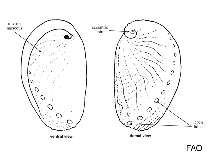Haliotis cracherodii Leach, 1814
Black abalone| Native range | All suitable habitat | Point map | Year 2050 |

|
| This map was computer-generated and has not yet been reviewed. |
| Haliotis cracherodii AquaMaps Data sources: GBIF OBIS |
Upload your photos
Google image | No image available for this species;
drawing shows typical species in Haliotidae.
Google image | No image available for this species;
drawing shows typical species in Haliotidae.
Classification / Names Common names | Synonyms | CoL | ITIS | WoRMS
Gastropoda | Lepetellida | Haliotidae
Environment: milieu / climate zone / depth range / distribution range Ecology
Benthic; depth range 0 - 6 m (Ref. 865). Subtropical; 44°N - 28°N, 125°W - 113°W
Distribution Countries | FAO areas | Ecosystems | Occurrences | Introductions
Eastern Pacific: USA to Mexico. Historically occurred from Crescent City, California to southern Baja California, Mexico; however, current constricted range occurs from Point Arena, California to Bahia Tortugas, Mexico.
Length at first maturity / Size / Weight / Age
Maturity: Lm ?, range 5 - ? cm Max length : 29.0 cm SHW male/unsexed; (Ref. 312); max. reported age: 51 years (Ref. 8702)
Short description Morphology
Shell is dark blue-black and smooth. It is usually free from seaweed and other marine growth. The holes near the shell edge are used to carry of waste and release eggs and sperm (Ref. 312).
Fisheries: the meat is eaten fresh or dried; the shell is used as ornament or served as spoons or bowls (Ref. 312).
Life cycle and mating behavior Maturity | Reproduction | Spawning | Eggs | Fecundity | Larvae
Broadcast spawners (Ref. 105180).
Main reference
References | Coordinator | Collaborators
Gallivan, G. and J. Danforth. 1999. (Ref. 312)
IUCN Red List Status (Ref. 130435: Version 2024-1)
Critically Endangered (CR) (A2ade+3e); Date assessed: 04 January 2021
CITES status (Ref. 108899)
Not Evaluated
CMS (Ref. 116361)
Not Evaluated
Threat to humans
Human uses
Fisheries: commercial
| FishSource |
Tools
More information
Trophic Ecology
Ecology
Population dynamics
Life cycle
Distribution
Human Related
Aquaculture profile
Stamps, Coins Misc.
Stamps, Coins Misc.
Outreach
References
Internet sources
BHL | BOLD Systems | CISTI | DiscoverLife | FAO(Publication : search) | Fishipedia | GenBank (genome, nucleotide) | GloBI | Gomexsi | Google Books | Google Scholar | Google | PubMed | Tree of Life | Wikipedia (Go, Search) | Zoological Record
Estimates based on models
Preferred temperature
(Ref. 115969): 12.2 - 18.6, mean 15.9 (based on 61 cells).



